Hello, and welcome to today’s Stories from Catbird Cottage! I am teaching a 3-course cooking class tomorrow, and the main event will showcase how to roast phenomenal chicken. I wanted to bring that here and share with all subscribers, since a great roast chicken is universally loved. If you’re able, thanks so much if you can upgrade to paid. Your support directly helps me to consistently create meaningful content here. As a supporter, you’ll receive two additional newsletters each month that delve deeper into my process, with additional behind the scenes and more zesty recipes.
Next week will feature a new recipe I’m over the moon for AND it is perfect for all your holiday menus! It will be for paid subscribers - here’s a sneak peek:
As you read further, I’ve included some tips I’ve found helpful to guarantee success, plus *three* linked, utterly sublime chicken dishes to bring you joy and comfort all the way through winter.
I don’t usually cook just chicken breasts, though they do make an appearance if I’m hungry for schnitzel or Marsala. When I eat chicken, I like the assurance that the meat will be juicy and flavorful. This usually means choosing darker meat - such as thighs - and it almost always means meat on the bone. It is harder to overcook bone-in meat of any kind. Bones add more flavor, and whether searing, braising, or roasting, it generally means the gift of greater juiciness. That said, there’s a time for everything and you can certainly cook chicken thighs sans bones. I sometimes do if I’m making spiedies, or this chile-garlic chicken pasta.
Without further ado, here are some terrific ways to succeed at roasting and searing chicken…
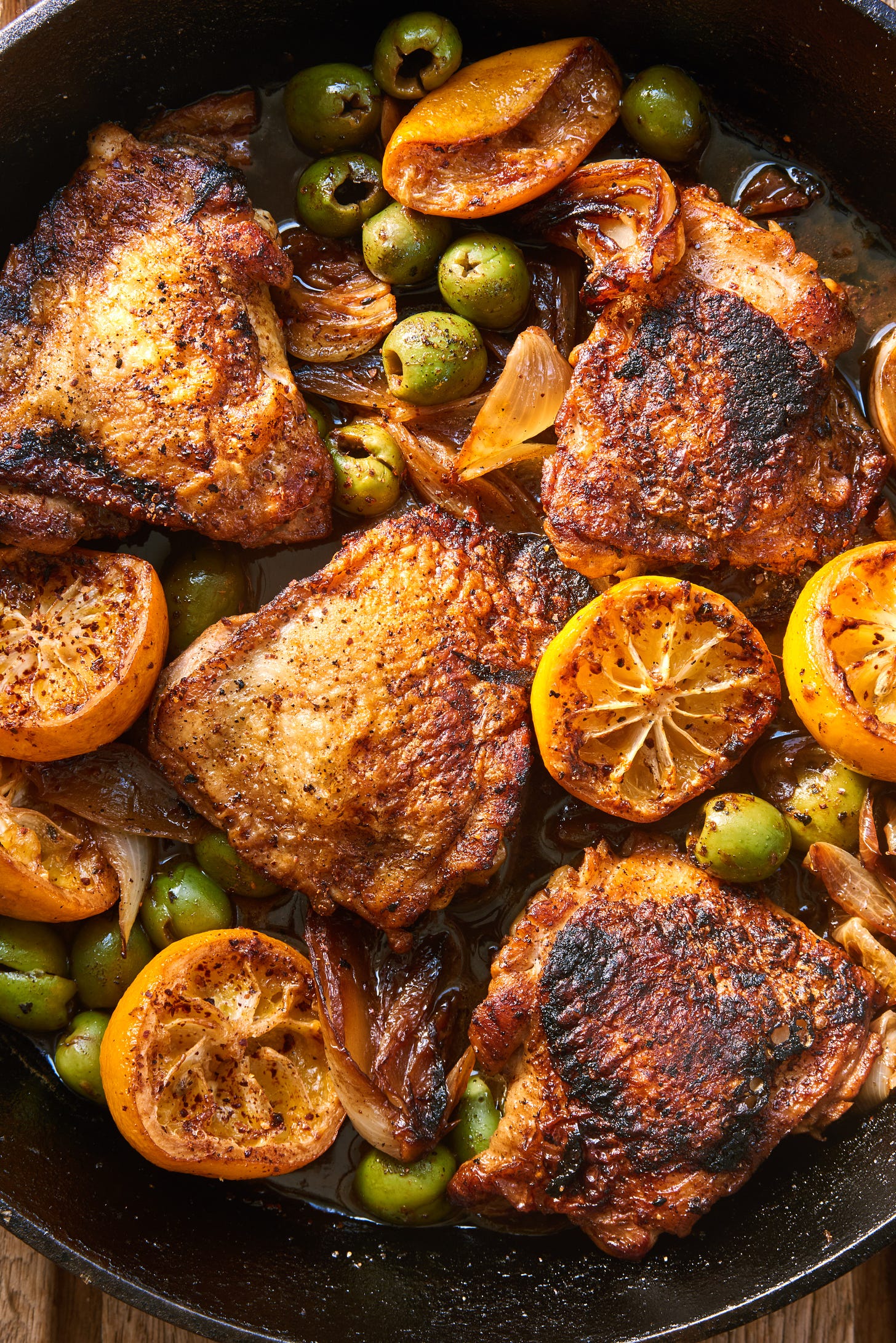
Tip #1: Always add umami. Umami is expressed as an extra savory flavor, more than just “salt”. Fermented and cured foods deliver this concentrated flavor and deepen the overall character of a dish.
As you season, keep in mind a little umami goes a long way!
Some examples include:
preserved lemons
capers
olives
anchovies
dried mushrooms, such as porcini or shiitake
chili paste, such as harissa or gochujang
Think of this aspect as anything that will bring extra savory depth to the mildness that chicken naturally is. Similarly, you could add small amounts of pancetta or bacon, soy sauce, or vinegar during the cooking process and be heartily rewarded when the cooking is done and it’s time to sit down and feast.
Tip #2: The trick to a beautifully golden whole roasted bird? Sear it prior to roasting and turn on all sides during that process. Literally. While the oven preheats, I lean a whole chicken on its side against the pan edge - often searing the veggies on the remaining surface area - to achieve the much sought after burnished, delectable effect. It is a big help if you tie the drumsticks together, which creates a tidier package during handling, and also helps the bird cook more evenly.
After one side has browned I rotate it to the next, using the top and bottom cavities to turn it (before it’s too hot to handle with my hands). Once the chicken is hot throughout, I use a set of tongs at one end and a spatula or another set of tongs at the other, and repeat turning and leaning until top, bottom, and sides develop that golden hue.
Once the chicken is browned on all sides I set it breast side up and continue in the cooking process. Mind you, while I endeavor browning the bird, I am also turning the veggies so they evenly brown, too! It’s kind of like a big game of memory, moving from one corner of the pan, across every element, turning each over for maximum delicious browned effect. The results are *consistently* huge grins and happy groans at the table.
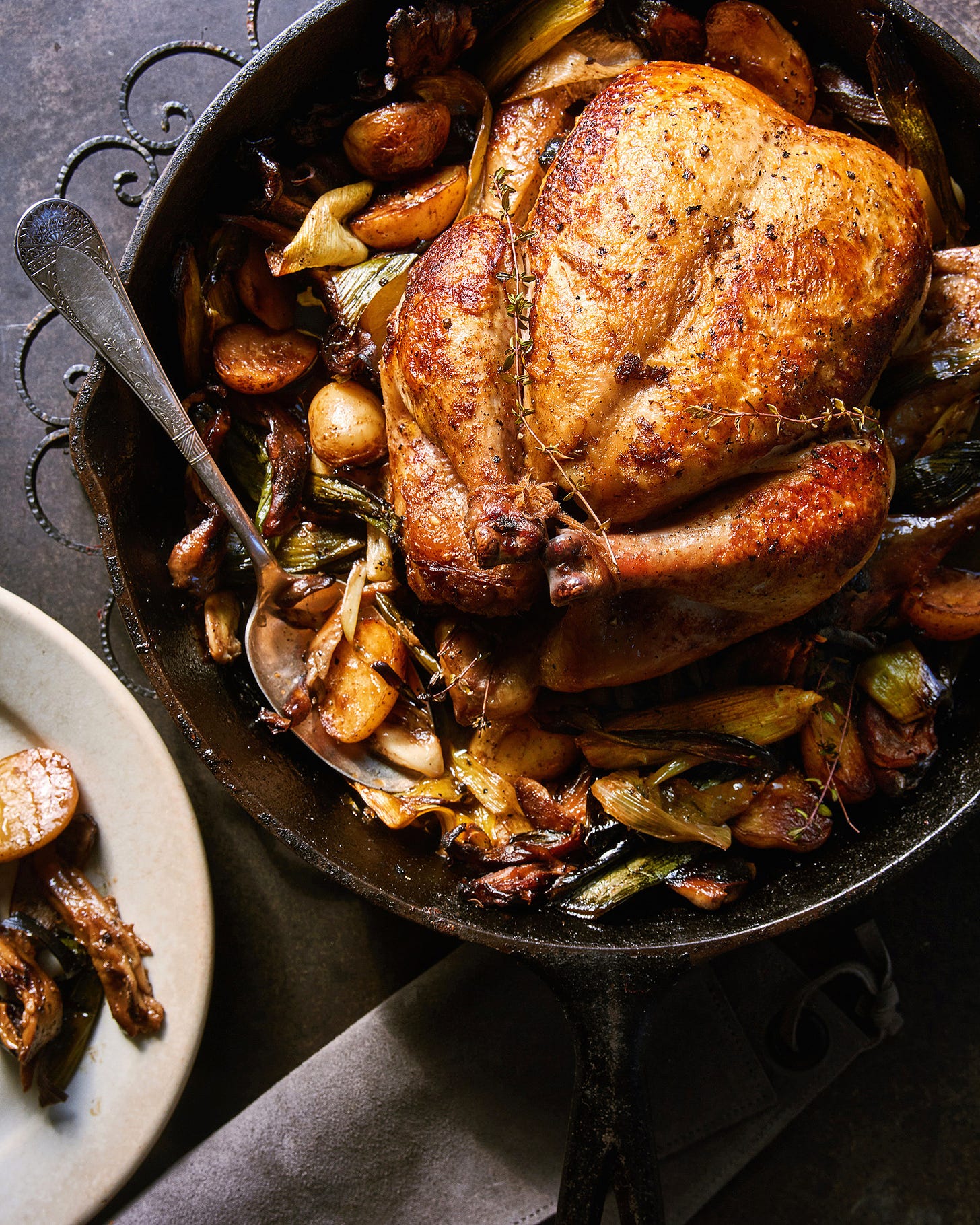
Tip #3: What should you cook with your chicken? So many things make for excellent support players! Quite often when I’m roasting a whole chicken it just so happens to be the cold weather season, and that means hearty root vegetables. Bonus: even though sturdy, root veggies get rendered tender (even sweet!) through the process. They are the perfect sides to your roasted meat.
sweet or waxy potatoes
carrots
onions, leeks, garlic, shallots
turnips, parsnips, kohlrabi
winter radishes
beets
If you’re just cooking thighs, or to add more things into the mix, these are terrific add-ins for more flavor and textures:
lemon slices or wedges
sliced fresh mushrooms, such as cremini, shiitake, maitake, and oysters
escarole
frilly kale
apples, grapes, or pears
winter squash, such as butternut, kabocha, and delicata
I confess to being guilty of crowding the pan when I roast a chicken. Not because I don’t care about the results - believe me, I love nothing more than a burnished bird and all the browned accompaniments. It’s precisely *because* I love the accompanying elements that I often fill my pan too-full, so I can feast on as many of these as I relish in the roasted meat.
I compensate for this by searing each element hard, on all sides. Once the steam dissipates, each carrot, potato, lemon, or other goodies *will* develop a gorgeous, deeply golden surface, whetting the appetite and ensuring rich flavors by the end.
If you favor burnished surfaces as I do and choose this route, don’t be tempted to disturb the pan. Allow everything to just sit there sizzling, cooking away their moisture, and re-drizzle oil as needed. After 3 minutes or so, turn the elements. If for some reason at that stage they need more time, go by 1-2 minute increments, leaving them be, then rotating or turning the veg.
It’s also useful to scoot any more-cooked elements from the hottest zone of the pan and replace them with elements that need more browning. I sometimes pile things up in the coolest zone, and turn the whole pile once in a while as the chicken (and other elements) finish cooking. Other times, if it really is too much to keep track of, I’ll transfer the cooked elements to a serving platter or sheet pan so I can focus on what remains, it may just take a little longer. Well worth it in the end!
Side note: if the above is an overwhelming amount of info to grasp, stick to keeping it simple and don’t crowd the pan. As someone who cooks all the time, I can forget that *how I do things* may not be how everyone else can (or should) do them.
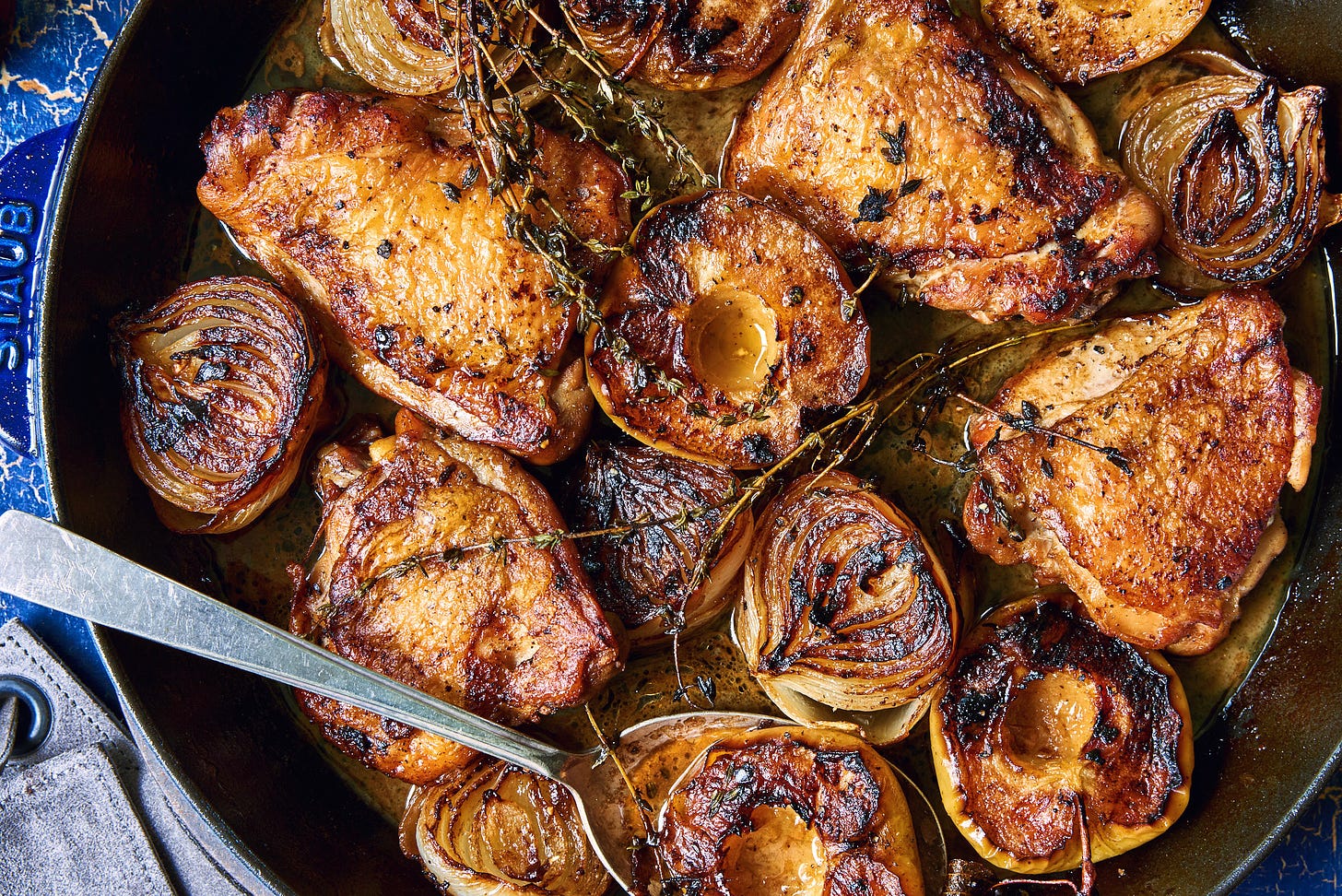
Tip #4: Adding liquid during the cooking process means you’ll have more pan jus, one of my fave parts of the meal. Wine, cider, or beer is often used to deglaze the pan once you’re past the searing stage. Doing so frees up the caramelized browned bits stuck to the bottom of the pan, and, you guessed it - also adds more character to the pan jus when it’s time to eat. Why? Because each of them is fermented, too.
After deglazing the pan and cooking some of the alcohol off, this is the moment to add the homemade stock you’ve dutifully made and stored in your freezer, *just for this moment*. If you don’t have homemade stock, use store-bought. It will still be flavorful, perhaps just not as nuanced. If you don’t have stock at all, simply use water and a splash of pickle brine. If you included umami elements and seared your ingredients well, the caramelized brown bits will add a depth to your pan jus. Plus the schmaltzy richness from cooking the chicken will mingle in there, too.
When the cooking liquid begins to bubble, it’s time to transfer the pan to the oven and finish the cooking process. Roasting in the oven finishes the bird all the way to the bone, it concentrates the pan jus, and renders everything in the cooking liquid jammy. It is a way of melding all the elements and gives the opportunity to walk away from the stove.
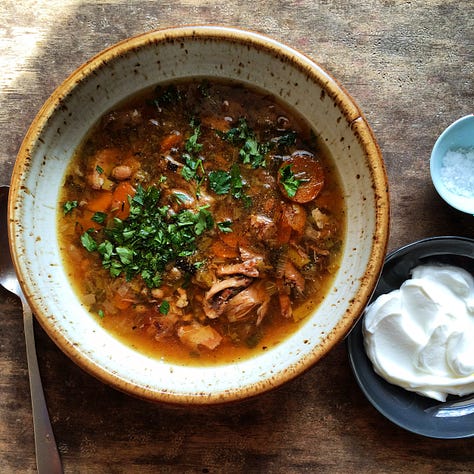
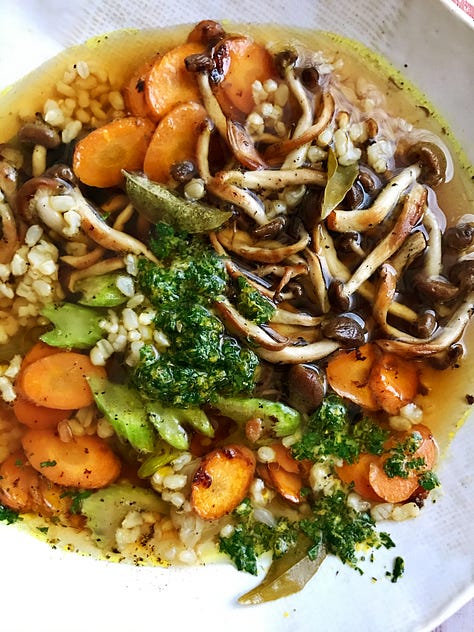
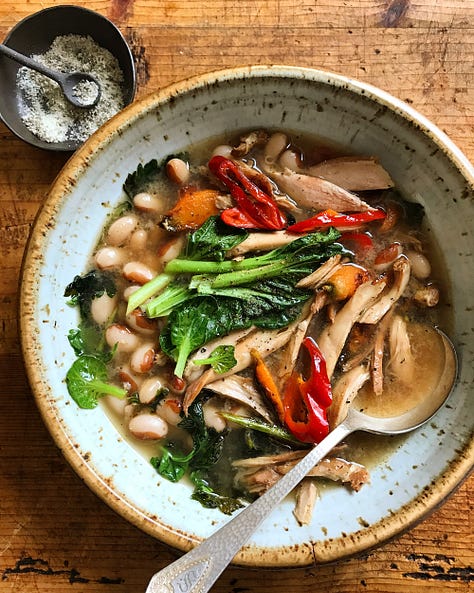
Last but not least, not a tip, but an important addendum:
If I’ve roasted bone-in chicken, I always *always* save the bones to make a new stock. It’s a full-circle opportunity you don’t want to miss: you’re presented with a perfect waste-not-want-not moment to wring final flavors from an already great thing, and stretch your dollars even further. Plus, soothing soup or stew is everyone’s happy place.
If I don’t have time to make stock immediately, I store the bones/carcass in a resealable bag in the freezer, along with end bits from numerous veg. Ready for whenever I am!
I hope sharing the jumble of the hows, whats, and whys here brings you to a new, clarifying place. If any of these layers resonated with you, I’d love to hear it in the comments… thanks! Cheers to the searing and roasting season….
Let’s stay in touch -
Follow me on Instagram, @melinahammer
Do you love A Year at Catbird Cottage? If so, please leave a review on Amazon, whether you purchased it there or not, which makes it easier for others to find my book. Thank you!
Catbird Cottage is our home in the Hudson Valley, NY, where I teach cooking and gardening workshops, and host intimate dinners, guided by the seasons. Drop a line to reserve a special meal or a delicious, invigorating workshop with your friends.
My website melinahammer.com carries an archive of many free recipes through the years, featuring fresh, seasonal ingredients that always bring wow to the table.




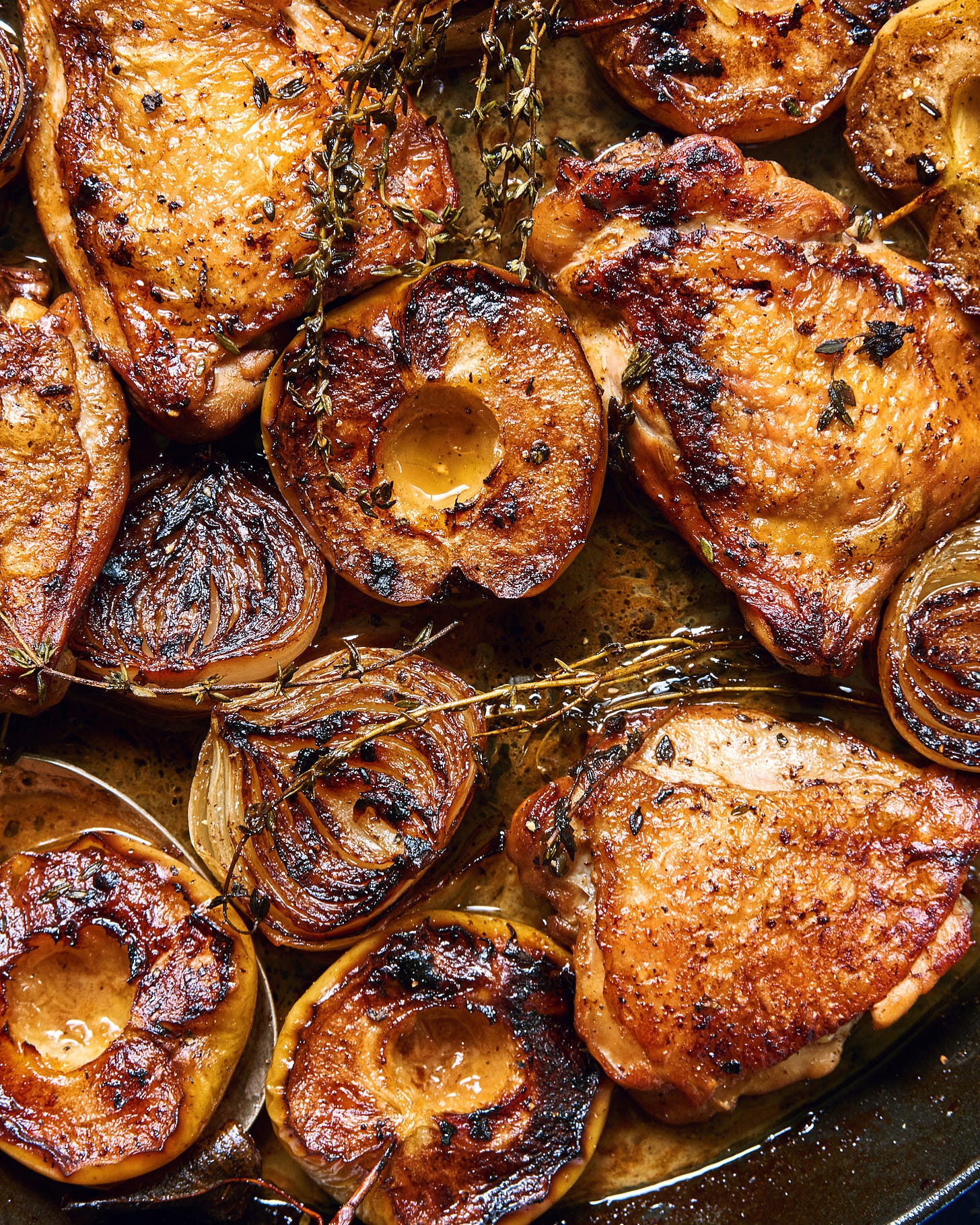
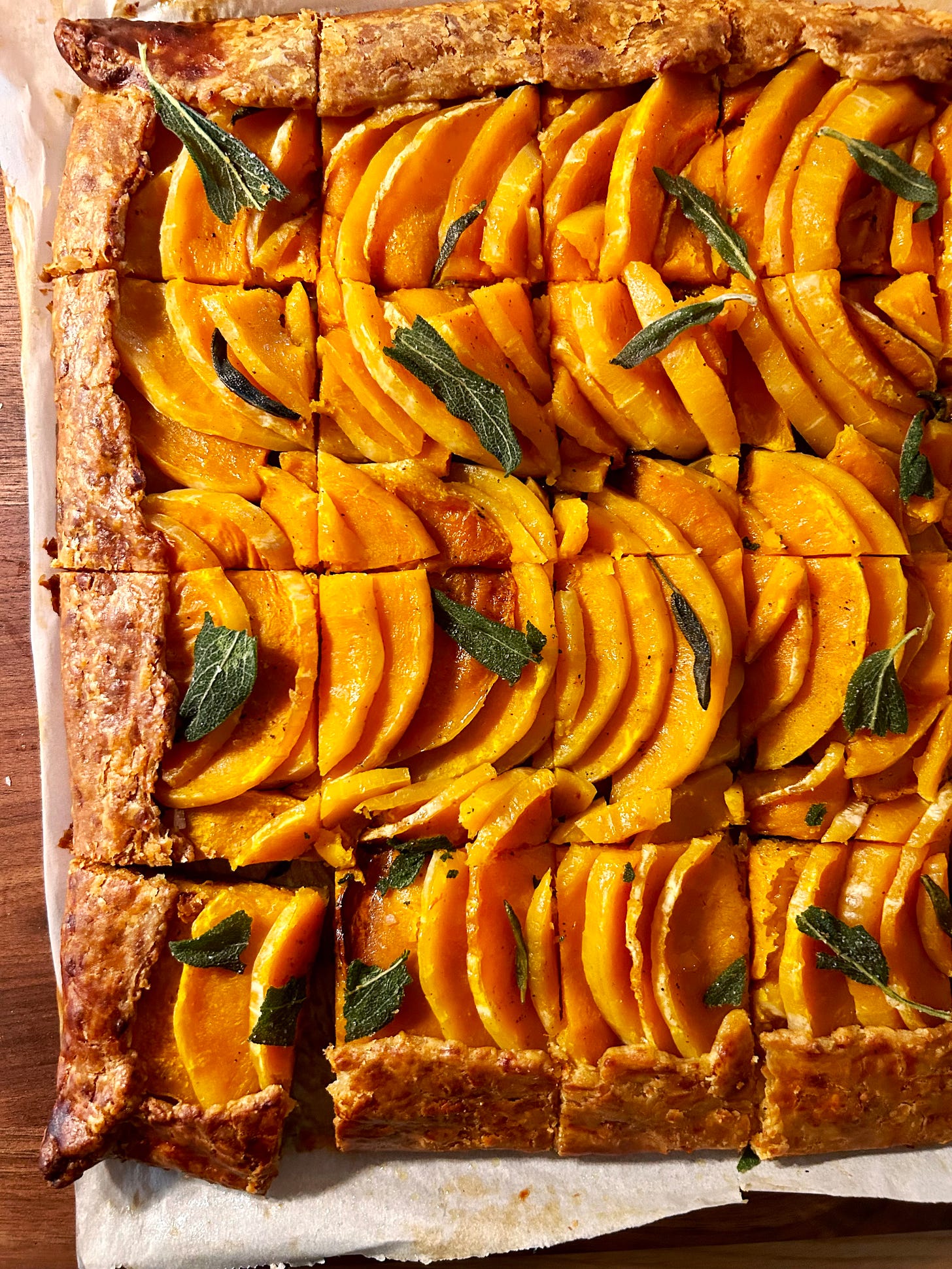
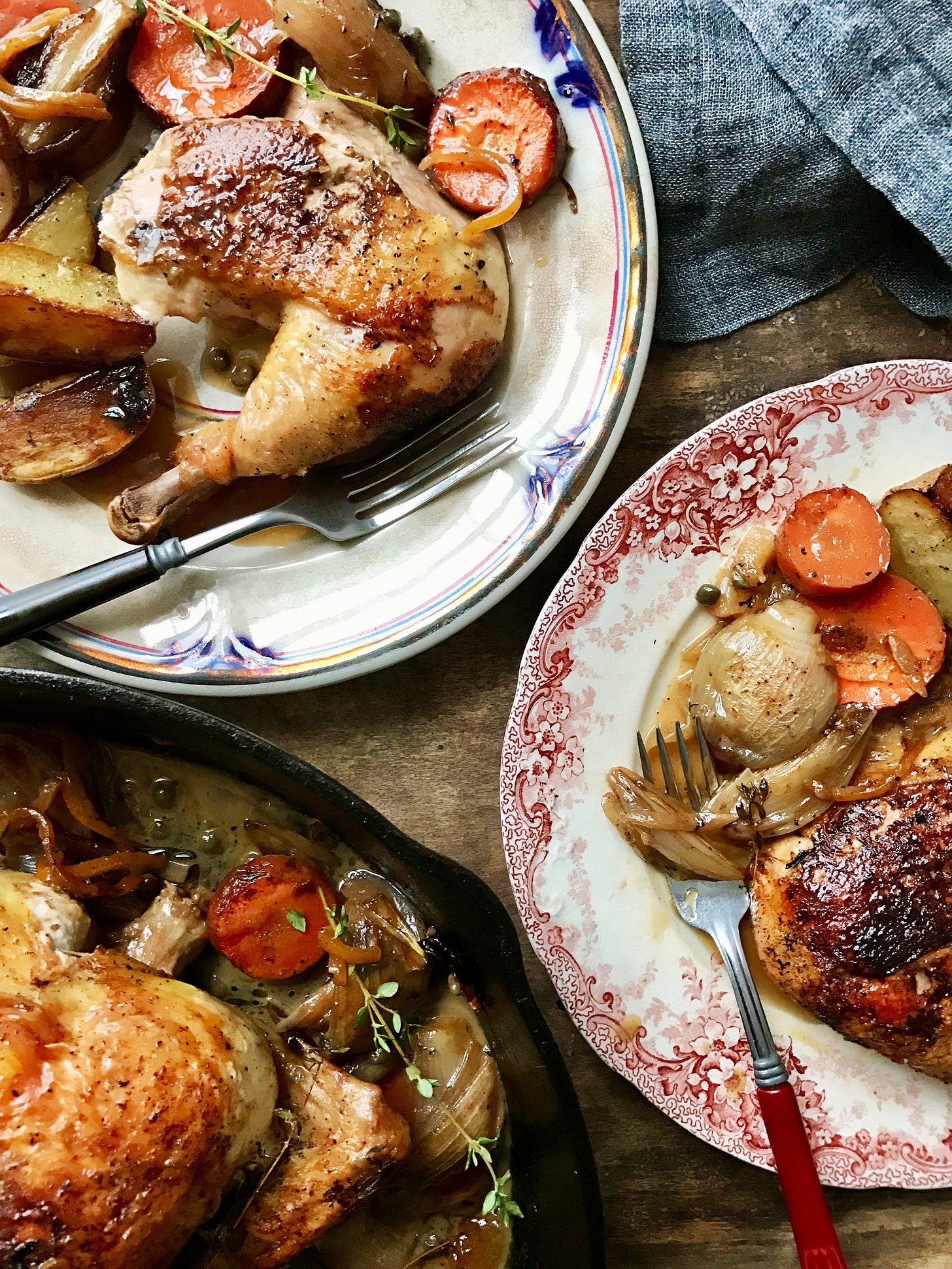
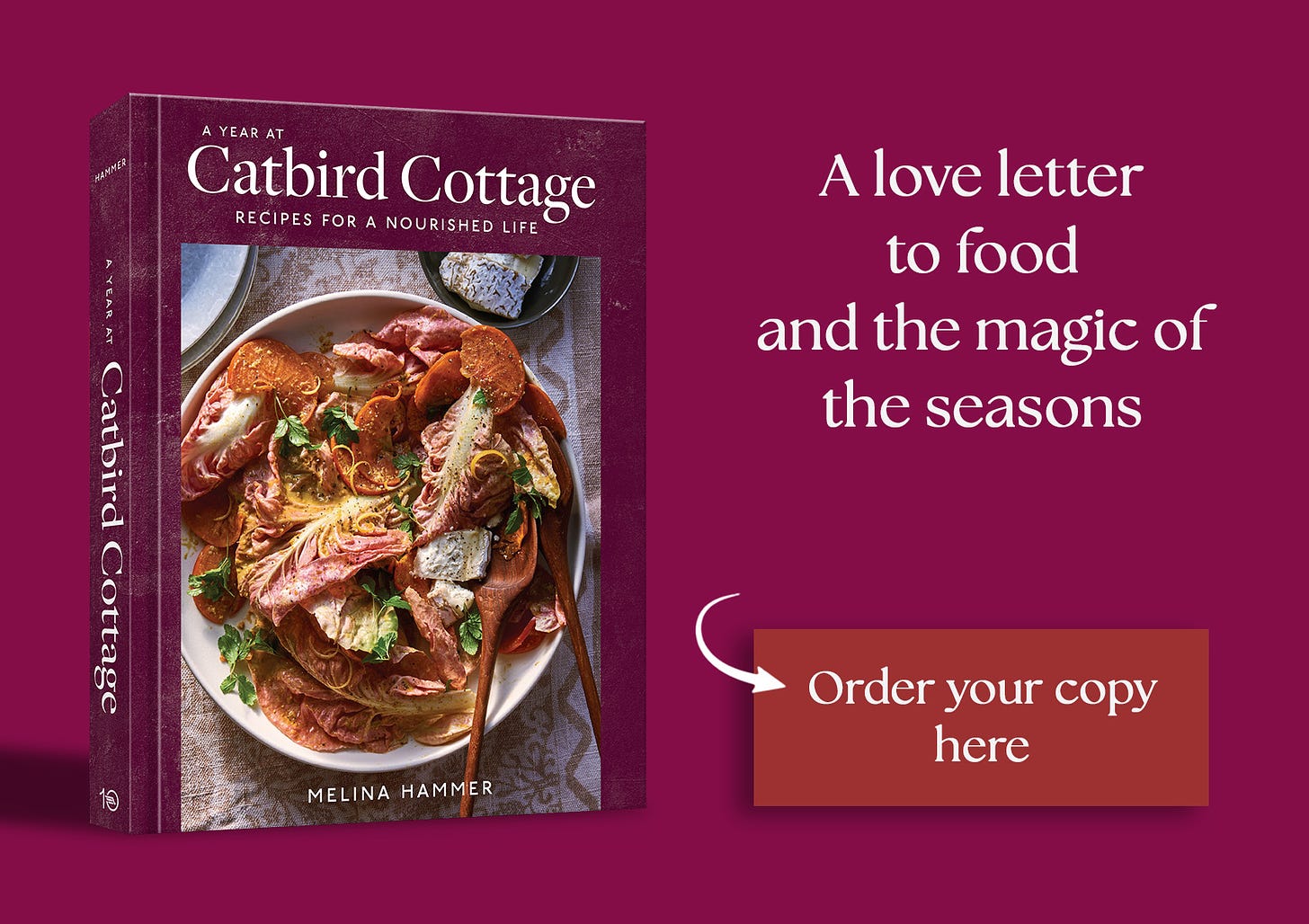
Thanks for these tips, Melina. Very helpful. I'm assuming you prefer cast iron for your chicken roasting? I may be biased, but I find cast iron to be superior for such uses. Thanks for the recipe links, though the one seems at NYT paid--I am sure Sam Sifton's recipe is great, but I am not paying for that access these days.
Here's hoping your Sat class went well! I am reading and very much appreciating your Stories cookbook--it resonates for certain. --Alan